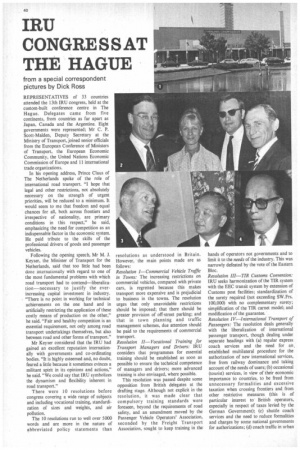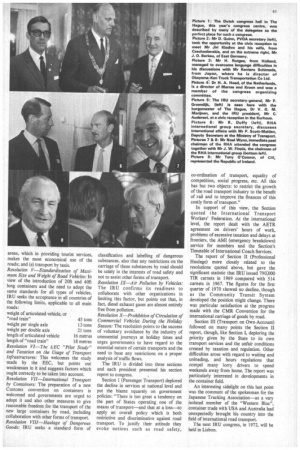IRU CONGRE S S AT THE HAGUE
Page 42

Page 43

If you've noticed an error in this article please click here to report it so we can fix it.
from a special correspondent pictures by Dick Ross
REPRESENTATIVES of 33 countries attended the 13th IRU Congress, held at the custom-built conference centre in The Hague. Delegates came from five continents, from countries as far apart as Japan, Canada and the Argentine. Eight governments were represented; Mr C. P. Scott-Malden, Deputy Secretary at the Ministry of Transport, joined senior officials from the European Conference of Ministers of Transport, the European Economic Community, the United Nations Economic Commission of Europe and 11 international trade organizations.
In his opening address, Prince Claus of The Netherlands spoke of the role of international road transport. "I hope that legal and other restrictions, not absolutely necessary on the strength of urgent priorities, will be reduced to a minimum. It would seem to me that freedom and equal chances for all, both across frontiers and irrespective of nationality, are primary conditions in this respect," he said, emphasizing the need for competition as an indispensable factor in the economic system. He paid tribute to the skills of the professional drivers of goods and passenger vehicles.
Following the opening speech, Mr M. J. Keyser, the Minister of Transport for the Netherlands, said that too little had been done internationally with regard to one of the most fundamental problems with which road transport had to contend—liberalization—necessary to justify the everincreasing capital investment in industry. "There is no point in working for technical achievements on the one hand and in artificially restricting the application of these costly means of production on the other," he said. "Fair and healthy competition is an essential requirement, not only among road transport undertakings themselves, but also between road and other forms of transport."
Mr Keyser considered that the IRU had gained an excellent reputation internationally with governments and co-ordinating bodies. "It is highly esteemed and, no doubt, feared a little because it sometimes evinces a militant spirit in its opinions and actions," he said. "We could say that IRU symbolizes the dynamism and flexibility inherent in road transport."
• There were 10 resolutions before congress covering a wide range of subjects and including vocational training, standardization of sizes and weights, and air pollution.
The 10 resolutions run to well over 5000 words and are more in the nature of abbreviated policy statements than resolutions as understood in Britain. However, ' the main points made are as follows: Resolution I—Commercial Vehicle Traffic in Towns: The increasing restrictions on commercial vehicles, compared with private cars, is regretted because this makes transport more expensive and is prejudicial to business in the towns. The resolution urges that only unavoidable restrictions should be imposed; that there should be greater provision of off-street parking; and that in town planning and traffic management schemes, due attention should be paid to the requirements of commercial transport.
Resolution II—Vocational Training for Transport Managers and Drivers: IRU considers that programmes for essential training should be established as soon as possible to ensure the technical competence of managers and drivers; more advanced training is also envisaged, where possible.
This resolution was passed despite some opposition from British delegates at the drafting stage. Although not explicit in the resolution, it was made clear that compulsory training standards were foreseen, beyond the requirements of road safety, and an amendment moved by the Passenger Vehicle Operators' Association, seconded by the Freight Transport Association, sought to keep training in the hands of operators not governments and to limit it to the needs of the industry. This was narrowly defeated by the vote of the Eastern Bloc.
Resolution III—TIR Customs Convention: IRU seeks harmonization of the TIR system with the EEC transit system by extension of Customs post facilities; standardization of the surety required (not exceeding SW.Frs. 100,000) with no complementary surety; simplification of the TIR carnet model; and modification of the guarantee.
Resolution IV—International Transport of Passengers: The resolution deals generally with the liberalization of international passenger transport, though dealing under separate headings with (a) regular express coach services and the need for an established multilateral procedure for the authorization of new international services, free from railway dominance and taking account of the needs of users; (b) occasional (tourist) services, in view of their economic importance to countries, to be freed from unnecessary formalities and excessive taxation when crossing frontiers and from other restrictive measures (this is of particular interest to British operators, especially in respect of taxes levied by the German Government); (c) shuttle coach services and the need to reduce formalities and charges by some national governments for authorizations; (d) coach traffic in urban areas, which in providing tourist services, makes the most economical use of the roads; and (e) transport by taxis.
Resolution V—Standardization of Maximum Size and Weight of Road Vehicles: In view of the introduction of 20ft and 40f1 long containers and the need to adopt the same standards for all types of vehicles, IRU seeks the acceptance in all countries of the following limits, applicable to all main roads: weight of articulated vehicle, or "road train" 45 tons weight per single axle 13 tons weight per double axle 21 tons length of articulated vehicle 16 metres length of "road train" 18 metres Resolution VI—The EEC "Pilot Study" and Taxation on the Usage of Transport Infrastructures: This welcomes the study made by the EEC, but points out weaknesses in it and suggests factors which ought correctly to be taken into account. Resolution VH—International Transport by Containers: The preparation of a new Customs convention on containers is welcomed and governments are urged to adopt it and also other measures to give reasonable freedom for the transport of the new large containers by road, including collaboration with other forms of transport. Resolution VIH—Haulage of Dangerous Goods: IRU seeks a standard form of classification and labelling of dangerous substances, also that any restrictions on the carriage of these substances by road should be solely in the interests of road safety and not to assist other forms of transport.
Resolution IX—Air Pollution by Vehicles: The IRU confirms its readiness to collaborate with other organizations in limiting this factor, but points out that, in fact, diesel exhaust gases are almost entirely free from pollution.
Resolution X—Prohibition of Circulation of Commercial Vehicles During the Holiday Season: The resolution points to the success of voluntary avoidance by the industry of unessential journeys at holiday times and urges governments to have regard to the essential nature of certain transports and the need to base any restrictions on a proper analysis of traffic flows.
The IRU is divided into three sections and each president presented his section report to congress.
Section 1 (Passenger Transport) deplored the decline in services at national level and put the blame squarely on government policies: "There is too great a tendency on the part of States operating one of the means of transport—and that at a loss—to apply an overall policy which is both restrictive and discriminative against road transport. To justify their attitude they evoke notions such as road safety, co-ordination of transport, equality of competition, social progress, etc. All this has but two objects: to restrict the growth of the road transport industry to the benefit of rail and to improve the finances of this costly form of transport."
In support of this view, the Section quoted the International Transport Workers' Federation. At the international level, the report dealt with the AETR agreement on drivers' hours of work, problems of excessive taxation and delays at frontiers, the AM! (emergency breakdown) service for members and the Section's Timetable of International Coach Services.
The report of Section II (Professional Haulage) more closely related to the resolutions quoted above, but gave the significant statistic that IRU issued 790;000 TIR carnets in 1969 compared with 514 carnets in 1967. The figures for the first quarter of 1970 showed no decline, though as the Community Transit System developed the position might change. There was particular satisfaction at the progress made with the CMR Convention for the international carriage of goods by road.
Section III (Transport on Own-Account) followed on many points the Section II report, though, like Section I, deploring the priority given by the State to its own transport services and the unfair conditions created by taxation and regulation. Other difficulties arose with regard to waiting and unloading, and hours regulations that compel many lorry drivers to spend weekends away from home. The report was particularly interested in developments in the container field.
An interesting sidelight on this last point was the comment of the spokesman for the Japanese Trucking Association—as a very isolated member of the "Western Bloc", container trade with USA and Australia had unexpectedly brought his country into the field of international road transport.
The next IRU congress, in 1972, will be held in Lisbon.
























































































































